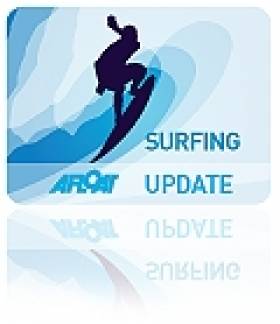Displaying items by tag: kian egan
Ride Waves In The Wake Of Westlife – Or Mix Yoga With Your Surfing
#Surfing - The members of Westlife are well known for hailing from the 'Land of Heart's Desire' – Co Sligo. But did you know one of the group, Kian Egan, is a keen surfer?
It should make sense, when you think about it, with Mullaghmore Head attracting the world's top big wave surfers for many years now, and Strandhill producing world-class waveriders and bodyboarders.
And thanks to this travelogue in The Irish Times by Seamus McGoldrick, we can learn a lot more about the Westlife singer's passion for the waves on a surfing trip to the Canary Islands organised by childhood friend Allan Mulrooney.
However, if bumming around Fuertaventura in search of the most primo surf doesn't sound like your kind of holiday, perhaps a trip combining surfing with yoga might do the trick.
In the Irish Independent, Justine Carberry writes on her laidback getaway to a small fishing village in Morocco called Taghazout, where Irish couple Michelle and Michael Moroney run a yoga retreat adjacent to some of the best surfing the North African country has to offer.
Carberry's week-long stay also took in the attractions Morocco is perhaps best known for, such as the bustling medina markets and fragrant, vibrant cuisine.
But if you can't find the time to get that far away, the Moroneys also run yoga and surfing retreats in Ireland - with the latest taking place near the Cliffs of Moher, as The Irish Times reports.
Kian Egan Gets His Welly On to Raise Funds for Irish Lifeboats
#kianegan – Voice of Ireland judge and former Westlife member Kian Egan has teamed up with the RNLI's volunteer lifeboat crews to lend his support to their Mayday campaign. From Thursday 1 May until Monday 5 May the charity's volunteers will be selling yellow welly pin badges and key rings for a €2 donation, in cities, towns and villages throughout Ireland. There will also be a number of welly themed events held to raise funds for the lifesaving charity in Ireland.
The yellow welly was chosen to represent volunteer lifeboat crews for the Mayday campaign as it is an essential piece of RNLI crew kit. Waterproof with steel-capped toes, the specially designed boots keep the volunteer crew's feet warm and dry while also protecting them in dangerous conditions on deck. During gale force winds, rain and ice, keeping a sure footing can mean the difference between life and death for the volunteers.
Volunteer lifeboat crew have responded to the Mayday calls of those in trouble around Ireland's coastline for 190 years. These lifeboat crews that are on call every day, all year round, have spent an average of 137 hours at sea over Mayday weekends for the last 10 years. Many have full-time jobs and carry a pager with them at all times to alert them to a lifeboat callout.
Helping RNLI volunteer lifeboat crew from Sligo launch Mayday, The Voice of Ireland judge and former Westlife member Kian Egan said: 'As someone who grew up in Sligo on the west coast of Ireland, I know how hard the members of the RNLI work, and how dedicated they are to a job that they carry out as volunteers. On call 24 hours a day and prepared to launch in all weathers, I have huge respect for these brave men and women who come from all walks of life. As a surfer and someone who spends a lot of my time in the sea, it is always reassuring to know that they are there if I ever need them.
Thanks to the generosity of the public, these volunteers are highly trained and equipped and can continue to offer their specialised skills. I would encourage everyone in Ireland to get involved with Mayday, and to show their support by buying a yellow welly key ring or pin badge or to hold a yellow welly themed fundraiser. We have a great love of the sea in Ireland and so many of us use it for fun or for work, and when we are out there the RNLI keep us safe, so go on, give it some welly from 1-5 May.'
The RNLI continues to invest in its volunteer lifeboat crews and in lifesaving on Irish waters. This year alone will see another station open, bringing the total number of the charity's lifeboat stations in Ireland to 45. It will be at Union Hall in Cork and will operate on a two year trial. There will also be an all weather lifeboat put on station at Clifden in Galway, where the lifeboat crew have almost completed their training for the new vessel. Helvick RNLI has also received a brand new Atlantic 85 lifeboat, which is due to be put on service soon. The Aran Island's RNLI lifeboat crew now board their lifeboat from a new pontoon, shaving precious minutes off their lifeboat launch times and next year will see the very first Shannon class lifeboat arrive in Ireland, to be placed on service at Lough Swilly in Donegal.
Pauline McGann, RNLI Community Fundraising Manager added: 'We are asking people to 'give it some welly' and get behind Mayday from 1-5 May. The RNLI is celebrating its 190th anniversary this year and during that time 144,000 lives have been saved by the charity. For some ideas on how to get involved and to see what is going on around the country people can visit www.rnli.org/MAYDAY People can also support the campaign by texting the word Mayday to 50300 to donate €2'*
Last year, RNLI lifeboat crews from Ireland's 44 lifeboat stations launched 1,087 times, rescuing 1,278 people.































































